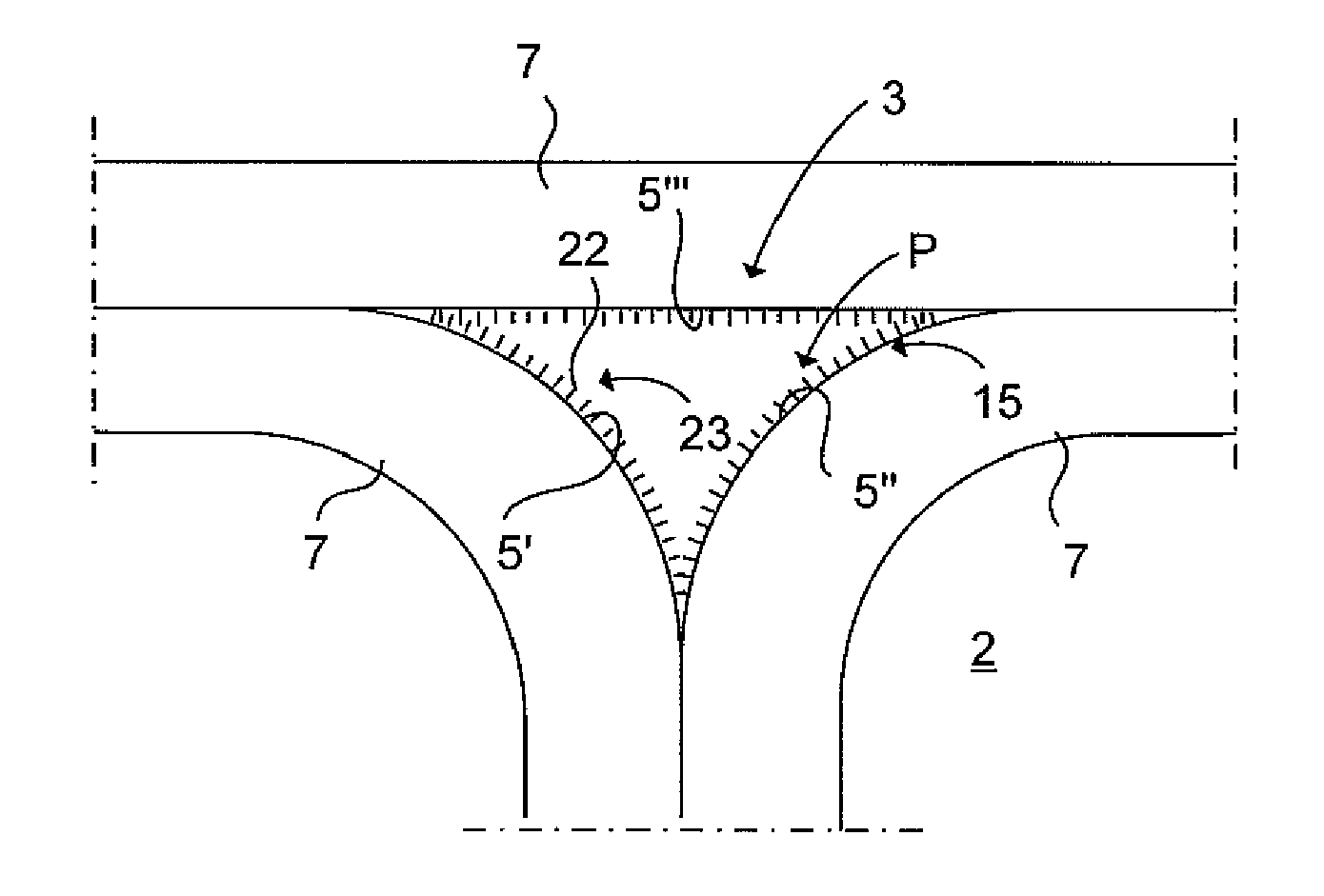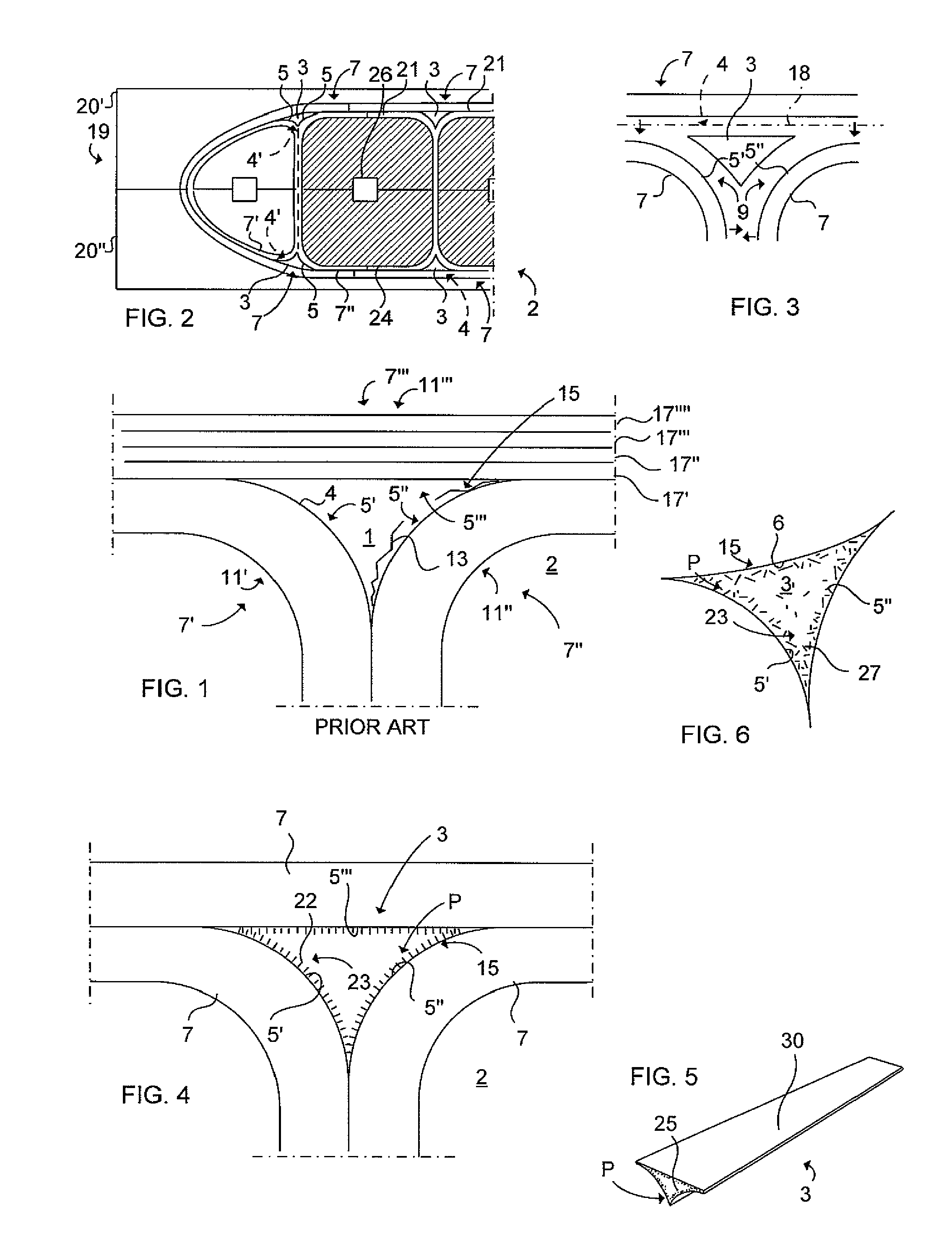Nano-reinforced radius filler for an aircraft structure and a method of producing an aircraft structure comprising such filler
a technology of nano-reinforced radius and aircraft structure, which is applied in the field of composite radius fillers, can solve the problems of affecting the cost effectiveness of the aircraft structure, the viscosity of the resin of the radius filler can be reduced, and the radius filler may be separated from the structural composite part, etc., and achieves cost-effectiveness and viscosity. the effect of the resin of the radius filler
- Summary
- Abstract
- Description
- Claims
- Application Information
AI Technical Summary
Benefits of technology
Problems solved by technology
Method used
Image
Examples
first embodiment
[0049]In FIG. 4 the radius filler 3 is schematically illustrated in a cross section according to the The composite radius filler is thus made structural by the nanostructure 23 arranged within the composite radius filler 3. According to this embodiment the nanostructure primarily is arranged in the periphery P of the composite radius filler for reinforcement of the interface area 15 between the composite radius filler 3 and the structural composite parts 7. The nanostructure 23 is in the form of nanofibers 22 and is oriented perpendicular against the respective structural composite part 7. In this way the aircraft structure 2 can be reinforced effective by means of a cost-effective feature in addition which is of low weight, meaning that the overall weight of the aircraft can be reduced. The nanostructure 23 located in the periphery P of the radius filler 3 hinders that any cracks will appear in the radius filler 3 near the interface area 15 between the radius filler 3 and the stru...
second embodiment
[0052]FIG. 5 illustrates a perspective view of a prolonged radius filler 3 according to a The nanostructure 23 comprises nanotubes 25 having a unidirectional orientation along the prolongation of the radius filler 3. The nanotubes 25 are located in the periphery P of the composite radius filler 3 for reinforcement of the interface area 15 between the composite radius filler 3 and the structural composite parts 7. The prolongation of the nanotubes is thus parallel with the prolongation of the radius filler, i.e. perpendicular to a plane corresponding with the shown triangular cross section of the radius filler 3.
[0053]In FIG. 5 is shown a radius filler 3 being arranged with a protective tape 30 for protecting the radius filler and to simplify the handling of the radius filler 3 in the production line. Also the viscosity can be controlled by the amount of nanostructure for an optimal handling of the composite radius filler under production. The radius filler 3 comprises a resin, whic...
third embodiment
[0054]FIG. 6 schematically illustrates a cross section of a radius filler 3 according to a The nanostructure comprises nanowires 27 being oriented unhomogeneous with a major part positioned in the periphery P of the composite radius filler 3 for reinforcement of the interface area 15 between the composite radius filler 3 and the structural composite parts 7. The nanowires 27 located within the periphery P of the radius filler 3 hinders that any cracks appear in the radius filler 3 near the interface area 15, which is a transition zone between the radius filler 3 and the structural composite part 7, during heavy stressing of the aircraft. The radius filler 3 in FIG. 6 has a triangular cross-section with three convex outer surfaces 5′, 5″, 6.
PUM
| Property | Measurement | Unit |
|---|---|---|
| Radius | aaaaa | aaaaa |
| Area | aaaaa | aaaaa |
Abstract
Description
Claims
Application Information
 Login to View More
Login to View More - R&D
- Intellectual Property
- Life Sciences
- Materials
- Tech Scout
- Unparalleled Data Quality
- Higher Quality Content
- 60% Fewer Hallucinations
Browse by: Latest US Patents, China's latest patents, Technical Efficacy Thesaurus, Application Domain, Technology Topic, Popular Technical Reports.
© 2025 PatSnap. All rights reserved.Legal|Privacy policy|Modern Slavery Act Transparency Statement|Sitemap|About US| Contact US: help@patsnap.com


